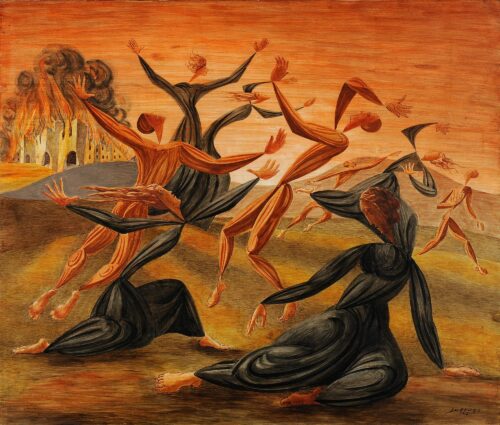
Survage Leopold (1879 - 1968)
Disaster, 1942
Known as Survage, he studied piano and at the same time acquired a business degree as he was scheduled to assume control of the family piano business. At the age of twenty-two he was attacked by a serious illness and turned toward painting. He studied at the Moscow School of Painting, Sculpture and Architecture.
He allied himself with the Russian avant garde and became a friend of Alexander Archipenko. In 1909 he settled in Paris and for a brief period of time attended Matisse’s school. He presented his first work in Paris in 1911 at the Salon d’ Automne, after being urged to do so by Archipenko.
In 1912 he moved on to Cubism, the same year as Mondrian and Diego Rivera. He produced abstract compositions using thinned ink under the title Colored Rhythm; its aim was to animate in precisely the same way as the cinema, giving a feeling of color and motion in space, thus creating “symphonies of color”, as the images followed one another. Several of these works were exhibited at the Salon d’ Automne in 1914 and the Salon des Independants in 1914. Apollinaire published laudatory articles about him and offered his support to this painter who landed a contract with the film production company Gaumont and designed one of the first abstract films, entitled Rytheme Colore. But the outbreak of war frustrated his plans.
He made costumes and sets for the Ballet Russe and his acquaintance with masson brought him into contact with surrealism.
The study of Byzantine art in his homeland influenced him in his later works, both in regard to the organization of his large decorative compositions and in the framing of the characteristic figures in his work. His subjects illustrate dramatic themes, composing ballets in strictly structured geometrical spaces.
In 1963 he became a member of the Legion of Honor.

Disaster, 1942

We use cookies to make our site work properly, to personalize content and ads, to provide social media features and to analyze our traffic. We also share information about how you use our site with our social media, advertising and analytics partners. Read the Cookies Policy.
These cookies are necessary for the website to function and cannot be switched off in our systems. They are usually only set in response to actions made by you which amount to a request for services, such as setting your privacy preferences, logging in or filling in forms. You can set your browser to block or alert you about these cookies, but some parts of the site will not then work. These cookies do not store any personally identifiable information.
If you disable this cookie, we will not be able to save your preferences. This means that every time you visit this website you will need to enable or disable cookies again.
These cookies tell us about how you use the site and they help us to make it better. For example these cookies count the number of visitors to our website and see how visitors move around when they are using it. This helps us to improve the way our site works, for example, by ensuring that users find what they are looking for easily. Our website uses Google Analytics for statistics reporting.
Please enable Strictly Necessary Cookies first so that we can save your preferences!